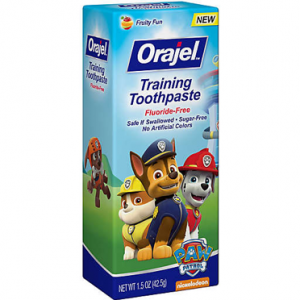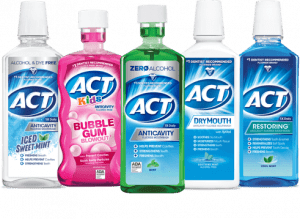Disclosure:: This post is sponsored by Lafayette Pediatric Dentistry (a pediatric dental practice right here in Lafayette, LA) and authored by Dr. Anita Gouri.
What Toothpaste do Dentists REALLY Recommend?
 Tartar Protection. Whitening. Sensitive teeth. Sensitive gums. Gum care. Triple Action. Pro Health. Training toothpaste. Kids toothpaste.
Tartar Protection. Whitening. Sensitive teeth. Sensitive gums. Gum care. Triple Action. Pro Health. Training toothpaste. Kids toothpaste.
It’s too much information and somehow also uninformative. What toothpaste should I use?And then what kind of toothpaste should my kids use? What about mouthwash? My answer, as the dentist, is usually: stick with the basics.
What’s actually in toothpaste anyway?
- Detergents for cleaning—usually a substance called Sodium Laurel Sulfate
- Abrasives to remove stains, like silicates and calcium carbonate
- Humectants like sorbitol and glycerol, which trap moisture
- Fluoride (usually Sodium fluoride)
- Minor ingredients like thickening agents, stabilizers, pH buffers and flavors
For children, this is all you need. We stick to the “keep it simple” philosophy: use basic fluoride kids’ toothpaste.
Kids’ toothpastes are specially formulated to have less harsh flavors and abrasives for little mouths. Fluoride is a naturally occurring element which remains the only known ingredient that fights tooth decay by strengthening the enamel. Just make sure to use only a smear of paste for children under three, who can’t spit out toothpaste yet, so they don’t swallow too much! Avoid all the “bells and whistles” toothpastes, such as whitening or gum care pastes, as some of these extra ingredients can be a little harsh or unnecessary for a child’s mouth. Examples of some good pastes for kids: Tom’s of Maine Natural Anti-Cavity Kid’s Toothpaste, Aquafresh Bubble Mint Toothpaste, Crest Kids’ Cavity Protection Toothpaste.
The training toothpaste is typically fluoride-free, for children too young to spit out that are also receiving an external source of fluoride, like a fluoride vitamin or fluoridated water. If an outside source of fluoride is not also being ingested, then switch your child to fluoride toothpaste, just using a very small amount on the brush. If they swallow a very small amount, it is safe and actually beneficial for the developing permanent teeth as well.
For adults, we still recommend a basic fluoridated toothpaste, but if you’re looking for a little extra out of your toothpaste, then here’s what to know about the bells and whistles:
- Whitening toothpastes contain certain abrasives or sometimes hydrogen peroxide, which are designed to remove only surface stains. This is perfectly fine to use, but just be aware that only minimal whitening can be achieved with these toothpastes, as they don’t actually contain bleaching agents. For that you need to see your dentist for professional whitening.
- For teeth that have a lot of erosion already (ie from acid or grinding), whitening toothpaste abrasives may cause even more wear on the teeth, and aren’t the best choice here.
- “Tartar control” ingredients like pyrophosphates are marketed to help combat the stubborn buildup on your teeth, which is simply plaque that has remained on your teeth long enough to calcify. Be aware that tartar is physically hard to remove with a toothbrush alone, so “tartar control” can be misleading. No chemical can truly break up tartar better than the thorough removal of plaque and tartar from brushing, flossing, and professional cleanings. So for true tartar control, see your dentist twice a year.
- I generally recommend avoiding the ingredient Triclosan, which is found in Colgate Total and is antibacterial. This is the ingredient that used to be found in antibacterial hand soaps until it was banned in 2016, when studies failed to show it was more effective than handwashing with regular soap and there was concern it could lead to bacterial resistance. Plus, since toothpaste acts like soap for the teeth and is already antimicrobial, Triclosan is really not necessary if brushing twice a day!
- Stannous Fluoride is a common ingredient found in toothpastes designed for more comprehensive gum care, along with dental care. Stannous Fluoride also strengthens enamel like sodium fluoride, but is scientifically proven to reduce gingivitis and gingival bleeding because it is more resistant to bacterial acid. For this reason, Stannous fluoride is found in toothpastes like Crest Gum Detoxify and Crest Pro Health. Some of my patients with more sensitive gums benefit from using these.
- For those with sensitive teeth, we recommend toothpastes with ingredients like postassium nitrate or strontium chloride, which do help to calm the nerve inside the tooth. Sensodyne is a great brand for this.
- For children or adults who get frequent aphthous ulcers in their mouths, try using a toothpaste that is free of Sodium Laurel Sulfate (SLS). Sensodyne Pronamel and certain products made by Tom’s of Maine are SLS-free, using milder detergents instead.
What about Mouthwashes?
The same rules apply: the bells and whistles are only minimally effective, but we do recommend using one with fluoride! For children, ensure first, of course, that they are old enough to spit out before introducing mouthwash. I like anything made by ACT, who makes good products for both kids and adults!
 To ensure you and your child are using the best products for your mouths, it’s best to have a comprehensive exam and consultation with your dentist first, so an individualized plan of care can be established.
To ensure you and your child are using the best products for your mouths, it’s best to have a comprehensive exam and consultation with your dentist first, so an individualized plan of care can be established.
Website | Facebook | Instagram | Twitter
Dr. Anita Gouri, a pediatric dentist, has been practicing in Lafayette for 10 years and is the  owner of Lafayette Pediatric Dentistry. She graduated from LSU School of Dentistry in 2006, receiving honors including Outstanding Achievement in Pediatric Dentistry, Honors in Research, and the Carl A. Baldridge Academic Scholarship. She completed her residency in pediatric dentistry at Children’s National Medical Center in Washington DC in 2008 and became a board certified diplomate of the American Board of Pediatric Dentistry in 2009. In 2010, her research on dental pain assessment was published in Pediatric Dentistry. She also has specialized training in treating babies and children who have tongue and lip ties. She is a member of the Academy of Laser Dentistry, American Academy of Pediatric Dentistry, the Louisiana Dental Association, the Southwestern Society of Pediatric Dentistry, American Dental Association, as well as the C. Edmund Kells and Omicron Kappa Upsilon Dental Honor Societies. Dr. Gouri, her husband, and their two children enjoy travel, Saints football, good food and good friends.
owner of Lafayette Pediatric Dentistry. She graduated from LSU School of Dentistry in 2006, receiving honors including Outstanding Achievement in Pediatric Dentistry, Honors in Research, and the Carl A. Baldridge Academic Scholarship. She completed her residency in pediatric dentistry at Children’s National Medical Center in Washington DC in 2008 and became a board certified diplomate of the American Board of Pediatric Dentistry in 2009. In 2010, her research on dental pain assessment was published in Pediatric Dentistry. She also has specialized training in treating babies and children who have tongue and lip ties. She is a member of the Academy of Laser Dentistry, American Academy of Pediatric Dentistry, the Louisiana Dental Association, the Southwestern Society of Pediatric Dentistry, American Dental Association, as well as the C. Edmund Kells and Omicron Kappa Upsilon Dental Honor Societies. Dr. Gouri, her husband, and their two children enjoy travel, Saints football, good food and good friends.


















